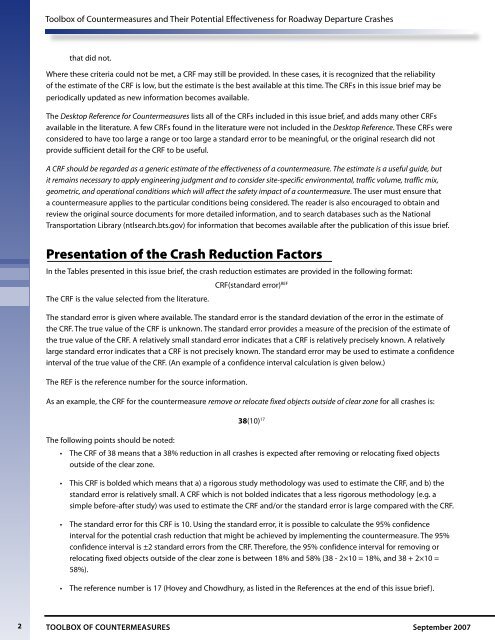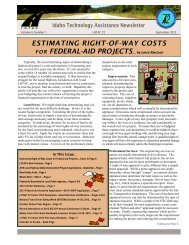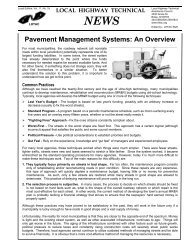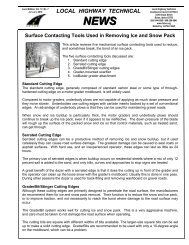Toolbox of Countermeasures and Their Potential Effectiveness for ...
Toolbox of Countermeasures and Their Potential Effectiveness for ...
Toolbox of Countermeasures and Their Potential Effectiveness for ...
Create successful ePaper yourself
Turn your PDF publications into a flip-book with our unique Google optimized e-Paper software.
<strong>Toolbox</strong> <strong>of</strong> <strong>Countermeasures</strong> <strong>and</strong> <strong>Their</strong> <strong>Potential</strong> <strong>Effectiveness</strong> <strong>for</strong> Roadway Departure Crashesthat did not.Where these criteria could not be met, a CRF may still be provided. In these cases, it is recognized that the reliability<strong>of</strong> the estimate <strong>of</strong> the CRF is low, but the estimate is the best available at this time. The CRFs in this issue brief may beperiodically updated as new in<strong>for</strong>mation becomes available.The Desktop Reference <strong>for</strong> <strong>Countermeasures</strong> lists all <strong>of</strong> the CRFs included in this issue brief, <strong>and</strong> adds many other CRFsavailable in the literature. A few CRFs found in the literature were not included in the Desktop Reference. These CRFs wereconsidered to have too large a range or too large a st<strong>and</strong>ard error to be meaningful, or the original research did notprovide sufficient detail <strong>for</strong> the CRF to be useful.A CRF should be regarded as a generic estimate <strong>of</strong> the effectiveness <strong>of</strong> a countermeasure. The estimate is a useful guide, butit remains necessary to apply engineering judgment <strong>and</strong> to consider site-specific environmental, traffic volume, traffic mix,geometric, <strong>and</strong> operational conditions which will affect the safety impact <strong>of</strong> a countermeasure. The user must ensure thata countermeasure applies to the particular conditions being considered. The reader is also encouraged to obtain <strong>and</strong>review the original source documents <strong>for</strong> more detailed in<strong>for</strong>mation, <strong>and</strong> to search databases such as the NationalTransportation Library (ntlsearch.bts.gov) <strong>for</strong> in<strong>for</strong>mation that becomes available after the publication <strong>of</strong> this issue brief.Presentation <strong>of</strong> the Crash Reduction FactorsIn the Tables presented in this issue brief, the crash reduction estimates are provided in the following <strong>for</strong>mat:The CRF is the value selected from the literature.CRF(st<strong>and</strong>ard error) REFThe st<strong>and</strong>ard error is given where available. The st<strong>and</strong>ard error is the st<strong>and</strong>ard deviation <strong>of</strong> the error in the estimate <strong>of</strong>the CRF. The true value <strong>of</strong> the CRF is unknown. The st<strong>and</strong>ard error provides a measure <strong>of</strong> the precision <strong>of</strong> the estimate <strong>of</strong>the true value <strong>of</strong> the CRF. A relatively small st<strong>and</strong>ard error indicates that a CRF is relatively precisely known. A relativelylarge st<strong>and</strong>ard error indicates that a CRF is not precisely known. The st<strong>and</strong>ard error may be used to estimate a confidenceinterval <strong>of</strong> the true value <strong>of</strong> the CRF. (An example <strong>of</strong> a confidence interval calculation is given below.)The REF is the reference number <strong>for</strong> the source in<strong>for</strong>mation.As an example, the CRF <strong>for</strong> the countermeasure remove or relocate fixed objects outside <strong>of</strong> clear zone <strong>for</strong> all crashes is:38(10) 17The following points should be noted:• The CRF <strong>of</strong> 38 means that a 38% reduction in all crashes is expected after removing or relocating fixed objectsoutside <strong>of</strong> the clear zone.• This CRF is bolded which means that a) a rigorous study methodology was used to estimate the CRF, <strong>and</strong> b) thest<strong>and</strong>ard error is relatively small. A CRF which is not bolded indicates that a less rigorous methodology (e.g. asimple be<strong>for</strong>e-after study) was used to estimate the CRF <strong>and</strong>/or the st<strong>and</strong>ard error is large compared with the CRF.• The st<strong>and</strong>ard error <strong>for</strong> this CRF is 10. Using the st<strong>and</strong>ard error, it is possible to calculate the 95% confidenceinterval <strong>for</strong> the potential crash reduction that might be achieved by implementing the countermeasure. The 95%confidence interval is ±2 st<strong>and</strong>ard errors from the CRF. There<strong>for</strong>e, the 95% confidence interval <strong>for</strong> removing orrelocating fixed objects outside <strong>of</strong> the clear zone is between 18% <strong>and</strong> 58% (38 - 2×10 = 18%, <strong>and</strong> 38 + 2×10 =58%).• The reference number is 17 (Hovey <strong>and</strong> Chowdhury, as listed in the References at the end <strong>of</strong> this issue brief).toolbox <strong>of</strong> countermeasures September 2007






